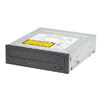A) Environmental Considerations in the disposal of computer system.
There is large Carbon footprint in IT production industry but that can be reduced by re-use and re-deployment of redundant IT equipments known as Computer Recycling.
Most of the environmental concerns with computers lie with the monitor, specifically its catode ray tube (CRT). On average, each color monitor contains 4 to 5 pounds of lead, considered hazardous waste when disposed of.
There are other hazardous materials in computers, including mercury, cadmium (also known carcinogen), and hexavalen Chromium (cause high blood pressure, iron-poor blood, liver disease, and nerve and brain damage in animals). Over 314 million computers were thrown away at the end of 2007.
Computer Recycling problem is, after upgrading computer system, most organizations store their old computers, which serve as backup equipment in case newer computers break down. decision must be made at some point about disposal of this equipment as continuing to store old computers is often not a viable option, it eventually takes up a considerable amount of space. The least desirable option is to throw old computers into the bin. computer recycling comes into the fore in every possible scenario, not just the effect it has upon the environment, there is also the possibility of someone removing hard drives and recovering sensitive data.
This drives to the point that data on hard disks should be destroyed - before getting rid of the computer or hard disk in it. Computer recycling isn't always about the environment, but of company and national safety importance too.
From an environmental point of view, it is far better to recycle your computer at an official recycling centre than to dispose of it.
Reference : Article source:
http://EzineArticles.com/?Computer-Recycling-For-Environmental-issues&id=1293414 , John Pettifer, 2009 EzineArticles.com - All Rights Reserved Worldwide.
B) OH+S considerations in the use of Computer Systems
Ergonomics is the term that refers to scitific discipline concerned with design according to human needs. It looks at what kind of work you do, what equipment you use and your entire job environment. The goal of ergonomics is to find best fit between you and your job conditions.
To setup an ergonomic computer workstation , make sure that teh computer is placed on a stable working surface with adequate room for proper arrangement. It's important to choose a comfortable chair for the user to sit in. Chair should be adjusted at a fixed height provided that its comfortable and has a good backrest that provides lumbar support.
A good workstation design will allow any computer user to work in a neutral, ideal typing posture that will minimize the risk of deveoping any injury.
A good workstation setup may include:
- Ergonomics keyboards and mouse
- Wrist rests
- Support braces/gloves
Other considerations are the following environmental conditions where computer will be used
- Lighting
- Ventilation
- Noise Take a break!
Make sure to practice the following to help avoid strain and injury
- Eye breaks every 15 minutes
- Rest breaks every 30 to 60 minutes.
- Exercise break every 1-2 hours.
Reference : Article Source: http://EzineArticles.com/?How-to-create-the-ideal-Ergonomic-workstation-&id=1330145 , SharonStage 2009, EzineArticles.com - All Rights reserved.











